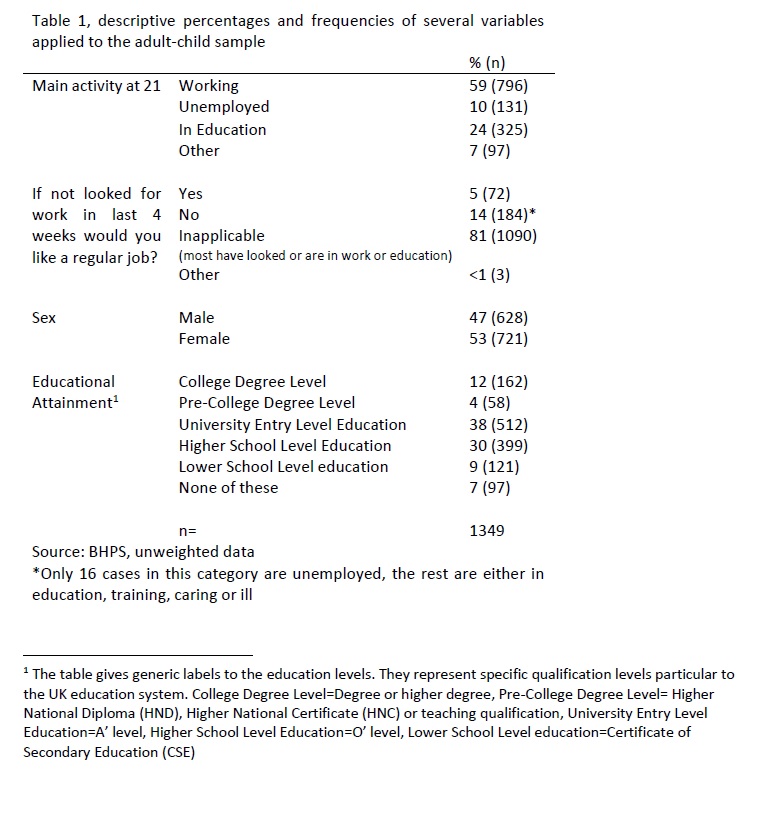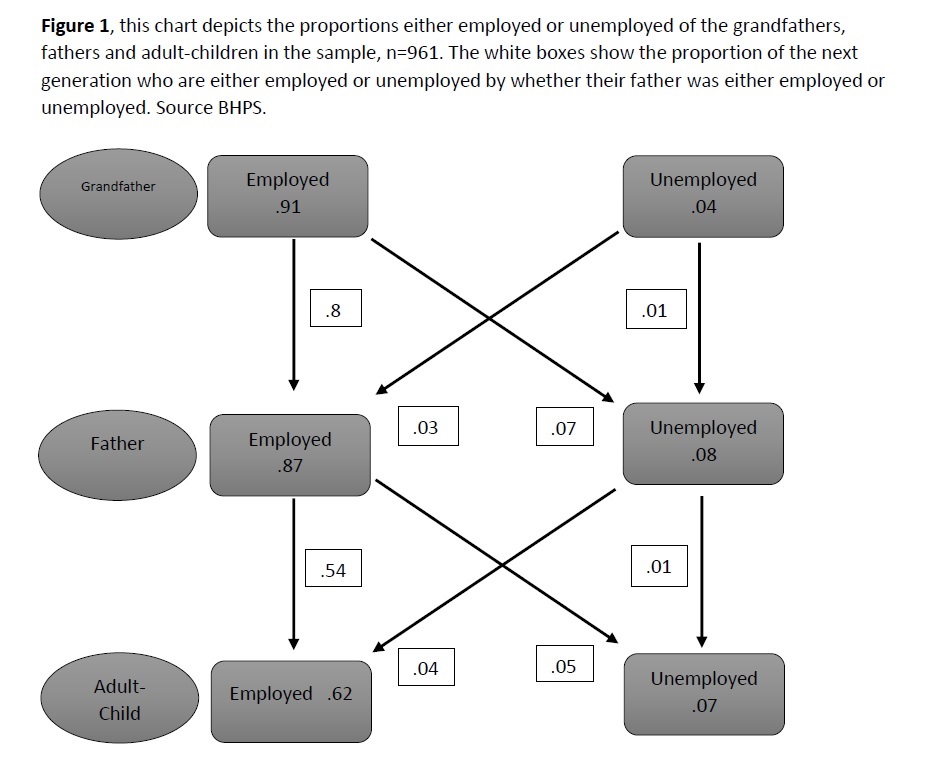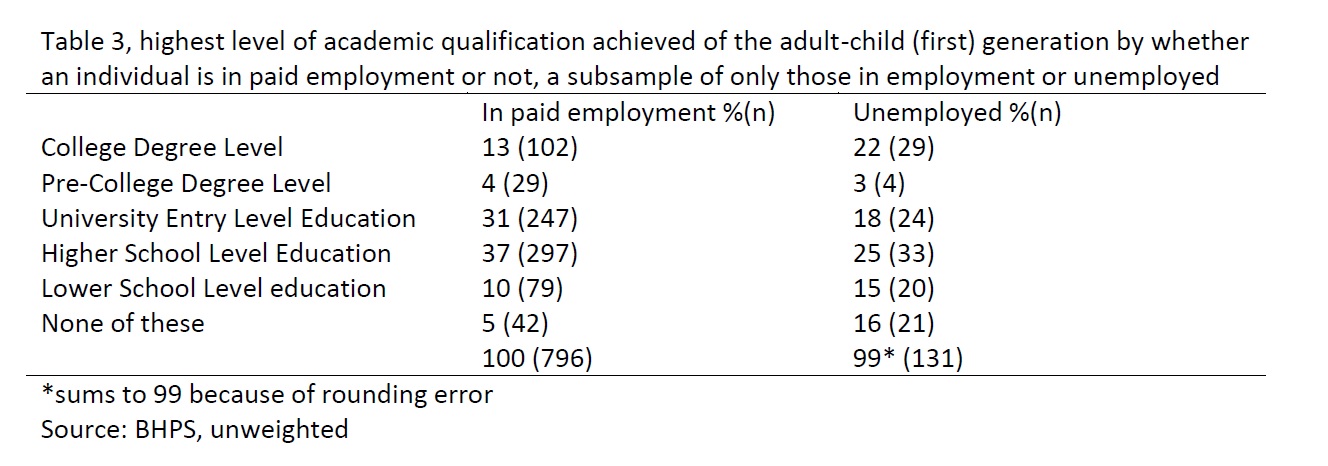Article: Exploring ‘generations and cultures of worklessness’ in contemporary Britain

Despite research which emphasises that the idea of 'generations of worklessness' is a myth, the general public, politicians and the mainstream media still suggest that generations and cultures of worklessness exist in contemporary Britain. Kevin Ralston and Vernon Gayle outline evidence that disputes this damaging myth.
Introduction
The concepts of generations and cultures of worklessness have popular, political and international resonance. In politics, high profile figures, such as the UK Government Minister Chris Grayling, are on record as stating there are ‘four generations of families where no-one has ever had a job’ (in MacDonald et al, 2013). Esther McVey, when she was UK Minister for Employment, made reference to the widespread idea that there is a ‘something for nothing culture’ among some of those claiming benefits (DWP, 2013). The general notion, that there is a section of undeserving poor who should receive punishment or correction, is a central concept in neo-liberal politics (Wiggan, 2012; Soss et al, 2011; Wacquant, 2009; de Goede, 1996). Ideas associated with generations and cultures of worklessness also regularly appear in the traditional UK print media and the international press. For example, in 2013, the Daily Mail reported the story of an individual convicted of burning down his house, which resulted in deaths. They reported his status as a benefit claimant and described living on welfare benefits as a ‘lifestyle choice’ for some.
These recent examples have been foreshadowed by long running debate. Ritchie et al (2005) suggest ideas similar to the generations and cultures of worklessness discourse go back 120 years. Katz (2013) argues that themes of this type have defined debate in the US for 200 years. Underclass theory provides a theoretical expression of the type of thinking present in such debates (Murray and Field, 1990). A foremost precept of underclass theory is the idea that problems of illegitimacy and crime negatively define sections of society (i.e. the underclass). Central to underclass theory is the idea that generations have been socialised into worklessness and that there is a social strata who are defined by their welfare dependency.
Evidence of cultural intergenerational worklessness
The Office for National Statistics (ONS) estimated that there are only 2% of households where no adult has ever worked (McInnes, 2012). Gaffney (2010) estimated the prevalence of households with two generations of worklessness, using a sample from the Labour Force Survey (LFS), at only 0.5% (an estimate of 20,230 of a possible total number of households of working age of 20,818,429).[1] Eighty-nine per cent of these households were lone parent households. Macmillan (2011) also used the LFS to examine two generations of worklessness. She estimated there were 15,300 ‘never worked’ households in the UK. Macmillan’s (2011) findings suggest that most of these cases occur where the younger generation have only recently left education. Where there is long term, inter-generational worklessness within households, this may be due to practical and social-structural issues associated with lone parenting, caring, and illness (Gaffney, 2010; Macmillan, 2011).
In an analysis focusing on areas with concentrated high unemployment, the Social Exclusion Unit reported that there was no evidence of different, or separate, values amongst those in these areas (SEU, 2004). MacDonald (2008) drew on data from several phases of primary research. He found that, not only are young people committed to the values of work, those whose parents had been unemployed identified this as an additional motivating factor in their desire to find employment (MacDonald 2008). The Prince’s Trust (2010) similarly found young people to be strongly committed to work. Shildrick et al (2012) undertook research searching for families where generations had never worked. They were unable to identify such families. Crisp et al (2009) gathered accounts from research participants in deprived neighbourhoods. They found that people agreed with the culture of worklessness thesis, in that they believed that there are those who have been socialised into worklessness. Although they did not personally know such families, they believed that generationally workless families existed.
Zwysen (2015) reported findings that seem to support the generations and cultures of worklessness discourse. He found young people, whose fathers were out of work, were themselves more satisfied out of work than in work. Zwysen (2015) also reported that young people, whose fathers were out of work, are more likely to be out of work themselves (Schoon, 2014; Mäder et al, 2015; see also Hérault and Kalb, 2016). The sample is taken from one wave of UK panel data, with unemployment measured at one time point. Oesch and Lipps (2012) studied the subjective wellbeing of those out of work using German and Swiss panel data. Their results are contrary to the idea that unemployment becomes normative and that those out of work are more satisfied. They found worklessness to be negatively associated with wellbeing, and that this is consistent in areas of high unemployment and amongst those who have been out of work for longer durations.
Schoon (2014) focused on the relationship between parental worklessness and the ‘not in education, employment or training’ (NEET) status of young people during the recent recession, circa 2008. She concluded that there is no support for the cultures of worklessness thesis. A historical case study of a geographical area of high unemployment in the UK, by Fletcher (2007), also found no support for the idea that there is a culture of a lack of commitment to work. Hérault and Kalb (2016) reported an association between fathers’ and sons’ unemployment levels, for fathers who have been out of work for over 6 months (there was no meaningful association between fathers and daughters). Macmillan (2011) found only 1% of sons to ‘never be working’ across the period of observation. Finally, a German study by Mäder (2015) found the association between unemployment amongst fathers and sons to be non-causal and to be explained by the similar backgrounds of fathers and sons. This replicated findings reported by Ekhaugen (2009) and Macmillan (2010).
Data and Methods
The research we present here uses the British Household Panel Survey (BHPS, 2010). Eighteen annual waves of data were collected before the sample was incorporated into the larger UK Household Longitudinal Study (Understanding Society – Taylor et al, 2001). When a child moves from a familial household they continue to be followed in the BHPS. Therefore, unlike previous studies, this analysis is not restricted to the familial household (e.g. Gaffney, 2010; Macmillan, 2011).
Analytical Sample
The analytical sample in this study is all young people in the BHPS who, at 16 years old, matured into the main adult sample, between 1993 and 2003 (n=2,538). This is a ‘rising 16’ sample, who are children of panel members, and who are added to the main panel as members themselves. They are linked to information on whether they are in work or not at aged 21, using BHPS waves 1998 to 2008 (n=1349, excluding cases lost through attrition). This is matched to information on whether an individual’s father had a job when the individual was aged 14 using BHPS waves 1991 to 2001, and linked to whether their grandfather had a job when their father was aged 14 (complete case sample n=691).
The analysis uses the completely linked sample of 691 to assess whether there are generations of worklessness. The larger sample of 1349, linked to information at age 21, is applied to assess evidence of cultures of worklessness. For clarity, the rising 16’s are referred to as the ‘adult-child’ generation (generation 1), their fathers referred to as fathers (generation 2) and their paternal grandfathers as grandfathers (generation 3).
How the three generations of interest relate to the BHPS structure:
- We used information from the survey to measure rising 16s (adult-child) economic activity and labour market participation, this is at age 21.
- From earlier waves of the survey we have the same measures relating to the fathers of the adult-child group. This includes their economic activity and labour market participation.
- A retrospective question asked of BHPS panel members ‘Thinking back to when you were 14, what job was your father doing at that time?’ This has been used to derive a variable on paternal employment that is generally available in the BHPS dataset. This is applied to provide information on whether the (paternal) grandfathers of the adult-child group were working or not.
Variables
Several variables are used in this paper (described in Table 1). These include the highest level of academic qualification an individual has obtained. Respondents were asked whether they had been looking for work, or not, in the past four weeks. If they had not, they were asked whether they would like a job. Variables capturing responses to these questions can be combined with a measure of current economic status and used to interpret whether a section of the sample have no interest in engaging with paid employment. The Cambridge Social Interaction and Stratification Scale (CAMSIS) was applied to assess employment aspirations. CAMSIS is a measure of occupational structure based upon social interaction patterns (Prandy and Jones, 2001). This has been produced using Standard Occupational Classification (SOC90) codes (Lambert and Prandy, 2012). CAMSIS scores have a range from 1 (least advantaged) to 99 (most advantaged) with a mean of 50 and a standard deviation of 15 in the national population.

Results
Are there generations of worklessness?
Figure 1 depicts the overall proportion occupying either employed or unemployed status and indicates the proportion from the next generation who remain in the same status or switch status. We note that .91 of grandfathers (generation 3) were recorded as employed when the father (generation 2) was age 14, and .04 were recorded as unemployed. There is a relatively smaller proportion of adult-children (generation 1) recorded as either in employment or unemployed at 21, compared to their fathers and grandfathers, because high numbers are in education (.26) at this point. A proportion of .01 of the total fathers were unemployed who also had a father (the grandfather) who was unemployed. A proportion of .01, of the total, of adult-children, were similarly unemployed, who also had a father who was unemployed. A larger proportion of those whose fathers had been employed were unemployed. The figure graphically illustrates the very small level of intergenerational unemployment (grandfather>father .01, father>adult-child .01). The majority were employed and had a father who was employed (grandfather>father .80, father>adult-child .54).

Only five fathers were recorded as unemployed who reported their fathers being out of work when they were 14. Of these five cases, three of the adult-child generation were in work at age 21 and the other two unemployed. Therefore, the percentage of the sample to which the category of three generations of worklessness could apply is 0.3%.
Do those out of work not wish to work?
The vast majority of the adult-child (generation 1) sample who were out of work reported that they actively seek paid employment or would like to be employed. Of the adult-child sample, selecting those categorized as unemployed, at age 21, there are 131 cases. Those who have not looked for work in the last 4 weeks were asked if they would like a regular paid job (Table 1). The majority of this sub-sample had recently been looking for work, or were in education, or involved in family care. 16 said they would not like to work. Those who said they would not like to work were not asked why this is the case. However, examination of their circumstance provides some context.
Twelve of the 16 who said they would not like to work were women and four men. Three of the men had university entry-level qualifications, the other had no recognised qualifications. Five of the women reported having no academic qualifications, one had a degree and the others were qualified between university entry-level and lower-school level. One of the 16 also responded that poor health limits their ability to participate in work. Five of the 16 were resident with their own children and another identified as a carer of a non-resident person. In these cases, it is unknown whether these circumstances directly impacted their employment status, because this information is not collected in the BHPS. However, significant caring responsibilities or a limiting illness would ordinarily be considered legitimate reasons not to be in paid employment.
Those who were unemployed and had been looking for work in the previous four weeks were asked whether they were looking for a particular job, or any job. 58 said they were searching for a particular job, 43 would take any job. The type of occupation an individual would like was also asked. Evidence of low employment aspirations here could be indicative of an adjustment of expectations which, over time, if employment is not obtained, might become an acceptance of a situation and form the basis of a culture of worklessness. It might also be an outcome associated with prior socialisation into low expectations.

The young men and women in the BHPS, who were out of work, aspired to a range of occupations. The CAMSIS score associated with these occupations shows men and women aspired to jobs at around the average level for the population (see Table 2). This is apparent because CAMSIS is constructed to have a score of 50 for an average occupation, which is included in the confidence interval for the male and female sample. Several individuals aspired towards what would be thought of as advantaged occupations. Some women identified ‘advertising management’, ‘author or journalist’, and ‘biological scientist or biochemist’ as the job they would like. The men also identified aiming towards various occupations including ‘scientist’, ‘financial manager’ and ‘chartered or certified accountant’. These unemployed young people do not appear demoralized in terms of the occupations they aspire to.
The level of occupations those out of work said they would like to have seems reflective of levels of educational attainment (see Table 3). Most had some recognised academic qualification indicating engagement with, rather than withdrawal from, processes leading to employment. A higher percentage of those adult-children (generation 1) who were out of work were likely to have a degree than those in work at age 21. 16% reported having no academic qualifications.
This analysis is limited in a number of respects. It depends on measures of individual employment status at specific ages. This enables an assertion to be made regarding the question of whether there is intergenerational worklessness. It says nothing about spells of unemployment or levels of underemployment, which are also important policy issues and which are often conflated with the generations and cultures of worklessness discourse. We do not attempt to assess the causes of unemployment or to empirically assess the reasons why people believe, apparently despite all the evidence, that there are generations and cultures of worklessness. Another limit is the substantial amount of attrition in the sample (Lipps, 2009). The main analytic sample, where information has been linked between individuals and their fathers and grandfathers, is only 27% of the base-line sample. Notwithstanding these limitations, the general finding, that there is no support for the existence of generations and cultures of worklessness, does not contradict what has been found elsewhere on this issue (SEU, 2004; Fletcher, 2007; MacDonald, 2008; Gaffney, 2010; Prince’s Trust, 2010; Macmillan, 2011; McInnes, 2012; Shildrick et al, 2012).

Conclusions – generations and cultures of worklessness are improperly held beliefs
The overall message is that large-scale nationally representative data provides no evidence of multiple generations of worklessness in contemporary Britain. We can conclude that there is no evidence of the intergenerational transmission of ‘workshy’ attitudes, and this questions the idea that children are socialised into worklessness. We found that the majority of young people who are not in work or education confirm they would like to work. Those who are not in work have also generally shown a commitment to education, with the majority gaining some form of academic qualification. Those out of work, who would like a job, have attainable employment aspirations. Only a small number who are unemployed said they would not like a job; a number of these young people are involved in caring or identify as being ill. Together, this evidence suggests that the majority of young people are not living a workless lifestyle.
Youth & Policy is run voluntarily on a non-profit basis. If you would like to support our work, you can donate any amount using the button below.
Last Updated: 12 October 2017
Footnotes:
[1] A proportion of just 0.00097 of the total number of households of working age in the UK.
References:
BHPS 2010. University of Essex. Institute for Social and Economic Research, British Household Panel Survey: Waves 1-18, 1991-2009 [computer file] 7th Edition. Colchester, Essex: UK Data Archive [distributor] July 2010 SN: 5151. Available at: http://dx.doi.org/10.5255/UKDA-SN-5151-1.
Crisp, R., Batty, E., Cole, I. and Robinson, D. 2009. Work and Worklessness in Deprived Neighbourhoods: Policy assumptions and personal experiences. York: Joseph Rowntree Foundation.
DWP 2013. Benefit sanctions – ending the ‘something for nothing’ culture. London: Department for Work and Pensions, Employment and Welfare reform. Available at: https://www.gov.uk/government/news/benefit-sanctions-ending-the-something-for-nothing-culture [Accessed: 22 September 2016].
Ekhaugen, T. 2009. Extracting the Causal Component from the Intergenerational Correlation in Unemployment. Journal of Population Economics 22(1), pp. 97–113.
Fletcher, D.R. 2007. A culture of worklessness? Historical insights from the Manor and Park area of Sheffield. Policy & Politics 35(1), pp. 65–85. doi: 10.1332/030557307779657748.
Gaffney, D. 2010. The myth of the intergenerational workless household. Left Foot Forward blog . Available at: http://leftfootforward.org/2010/09/the-myth-of-the-intergenerational-workless-household/ [Accessed: 22 September 2016].
de Goede, M. 1996. Ideology in the US Welfare Debate: Neo-Liberal Representations of Poverty. Discourse & Society 7(3), pp. 317–357. doi: 10.1177/0957926596007003003.
Hérault, N. and Kalb, G. 2016. Intergenerational correlation of labor market outcomes. Review of Economics of the Household 14(1), pp. 231–249. doi: 10.1007/s11150-013-9218-5.
Katz, M.B. 2013. The Undeserving Poor: America’s Enduring Confrontation with Poverty. 2nd ed. New York, USA: Oxford University Press.
Lambert, P.S. and Prandy, K. 2012. CAMSIS project webpages: Cambridge Social Interaction and Stratification Scales. Available at: http://www.camsis.stir.ac.uk/. [Accessed: 15 February 2016].
Lipps, O. 2009. Attrition of Households and Individuals in Panel Surveys. The German Socio-Economic Panel (SOEP): SOEPpapers on Multidisciplinary Panel Data Research 164. Available at: http://EconPapers.repec.org/RePEc:diw:diwsop:diw_sp164.
MacDonald, R. 2008. Disconnected Youth? Social Exclusion, the ‘Underclass’ and Economic Marginality. Social work and society: international online journal 6(2).
MacDonald, R., Shildrick, T. and Furlong, A. 2013. In search of ‘intergenerational cultures of worklessness’: Hunting the Yeti and shooting zombies. Critical Social Policy , pp. 199–220.
Macmillan, L. 2010. The Intergenerational Transmission of Worklessness in the UK. Bristol: CMPO Working Paper Series No. 10/231.
Macmillan, L. 2011. Measuring the intergenerational correlation of worklessness. Bristol: Centre for Market and Public Organisation, Working Paper No. 11/278.
Mäder, M., Muller, S., Riphahn, R.T. and Schwientek, C. 2015. Intergenerational transmission of unemployment–evidence for German sons. Jahrbücher für Nationalökonomie und Statistik 235(4–5), pp. 355–375.
McInnes, T. 2012. There is a Difference between ‘Workless’ and ‘Never Worked’. New Policy Institute . Available at: http://www.npi.org.uk/blog/work-and-pay/there-difference-between-workless-and-never-worked/ [Accessed: 22 September 2016].
Murray, C.A. and Field, F. 1990. The emerging British underclass. London: IEA Health and Welfare Unit London.
Oesch, D. and Lipps, O. 2012. Does Unemployment Hurt Less if There is More of it Around? A Panel Analysis of Life Satisfaction in Germany and Switzerland. European Sociological Review , pp. 1–13. doi: 10.1093/esr/jcs071.
Prandy, K. and Jones, F.L. 2001. An international comparative analysis of marriage patterns and social stratification. International Journal of Sociology and Social Policy 21(4/5/6), pp. 165–183.
Prince’s Trust 2010. Destined for the dole? Breaking the cycle of worklessness in the UK. London: Prince’s Trust.
Ritchie, H., Casebourne, J. and Rick, J. 2005. Understanding workless people and communities: a literature review. Department for Work and Pensions. Research Report 255. Department for work and pensions: Corporate Document Services.
Schoon, I. 2014. Parental worklessness and the experience of NEET among their offspring. Evidence from the Longitudinal Study of Young People in England (LSYPE). Longitudinal and Life Course Studies 5(2), pp. 129–150. doi: http://dx.doi.org/10.14301/llcs.v5i2.279.
SEU 2004. Jobs and Enterprise in Deprived Areas: Social Exclusion Unit Report. London: Office of the Deputy Prime Minister.
Shildrick, T., MacDonald, R., Furlong, A., Roden, J. and Crow, R. 2012. Are ‘cultures of worklessness’ passed down the generations. York: Joseph Rowntree Foundation.
Soss, J., Fording, R.C. and Schram, S.F. 2011. Disciplining the poor: Neoliberal paternalism and the persistent power of race. Chicago: University of Chicago Press.
Taylor, M.F. with Brice, J., Buck, N. and Prentice-Lane, E. 2001. British Household Panel Survey User Manual Volume A: Introduction,Technical Report and Appendices. Colchester: University of Essex.
Wacquant, L. 2009. Punishing the poor: The neoliberal government of social insecurity. Durham: Duke University Press.
Wiggan, J. 2012. Telling stories of 21st century welfare: The UK Coalition government and the neo-liberal discourse of worklessness and dependency. Critical Social Policy 32(3), pp. 383–405. doi: 10.1177/0261018312444413.
Zwysen, W. 2015. The effects of father’s worklessness on young adults in the UK. IZA Journal of European Labor Studies 4(2), pp. 1–15.
Biography:
Kevin Ralston is a Lecturer in Sociology at York St John University who researches inequalities.
Vernon Gayle is a Professor of Sociology and Social Statistics at the University of Edinburgh and his research interests include educational attainment and the sociology of youth.